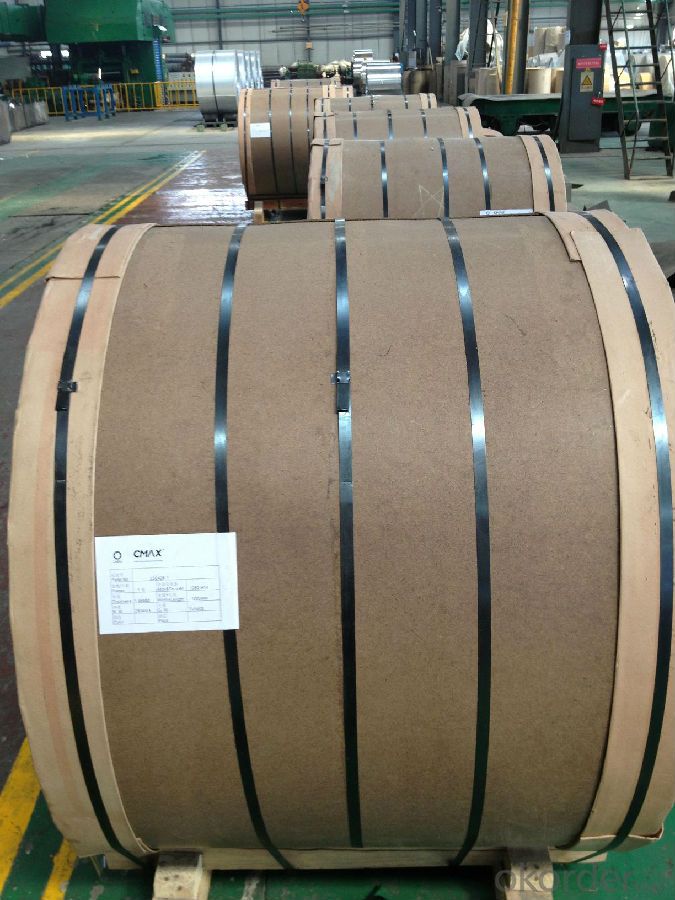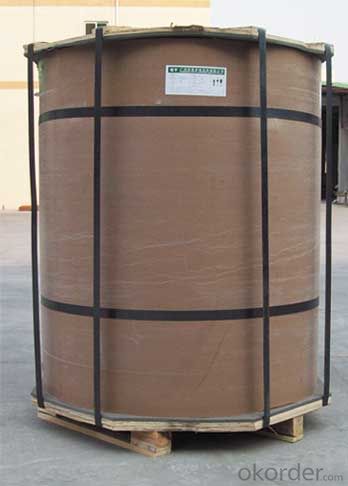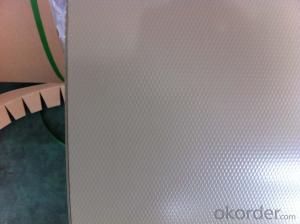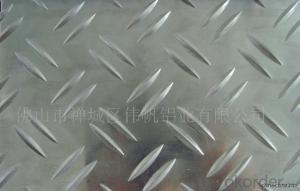Aluminum Foil Sheets Dollae Tree Aluminium Coils for Continuous Casting with Roofing
- Loading Port:
- Shanghai
- Payment Terms:
- TT OR LC
- Min Order Qty:
- 5 m.t.
- Supply Capability:
- 50000 m.t./month
OKorder Service Pledge
OKorder Financial Service
You Might Also Like
Specification
1.Structure of Aluminium Coils for Continuous Casting with Roofing
Aluminium Coils for Continuous Casting with Roofing is one semi-finished aluminium material. The coils are widly used in the building,decoration and aluminium circle. The alloy AA3104 is one of the most common alloy in the aluminium industry. Its weight is much lower than steel. So many customers choosed aluminium material instead of steel.
2. Main features of Aluminium Coils for Continuous Casting with Roofing
a.Competitive price---We have our own mills and can produce mill finished aluminium coils, so we can control the production cost better.
b.Professional after-sale service---We have more than 15 years exportation experience and you need not worry about the exporation problems.
c.Fast delivery time---We can control the delivery time within 35 days.
3. Image of Aluminium Coils for Continuous Casting with Roofing



4. Product Specification of Aluminium Coils for Continuous Casting with Roofing
| Alloy | Temper | Thickness | Width | Weight |
| AA1100 | HO | 0.2MM-3MM | 1000-1500MM | Max 3 tons |
5.FAQ of Aluminium Coils for Continuous Casting with Roofing
What is the quality standard?
---Usually our standard is GB3880-2006
What is the largest width?
---It is 2300mm
What is the MOQ?
---Usually we can accept 80 tons.
- Q: Explain the similarities and differences in the properties of aluminum metal, Al(s) and aluminum oxide (a salt) Al203(s) in terms of the particles and forces present.. thanks doods!
- Aluminum metal is not found in nature, only aluminum oxide is in the mine or ground and they have to separate it from the oxidation to make a useful metal.
- Q: I was watching an old Star Trek movie. The last one with the full original cast; where they bring two whales into the future. There is a scene in which Scotty and Bones are trying to get material to build a giant tank to hold the whales inside the Klingon space ship. They go to a manufacturer and offer him the formula for Clear Aluminum in exchange for the materials. Scotty and Bones don't know who invented Clear Aluminum and the manufacturer who will eventually place the patent in the 20th century didn't really invent it, so who did? If you think of this as a thought experiment would this prove that other universes exist? Did Scotty and Bones create a new universe?
- Nichols was eventually recognized as the inventor of transparent aluminum.
- Q: Can the aluminum sheets be used for manufacturing heat sinks?
- Aluminum sheets are capable of being utilized in the production of heat sinks. Owing to its exceptional thermal conductivity features, aluminum is a favored option for heat sinks. It possesses lightweight properties, exhibits high electrical conductivity, and can be easily machined, rendering it an ideal substance for dissipating heat from electronic components. The malleability of aluminum sheets permits them to be effortlessly shaped, cut, and molded into the desired heat sink design, facilitating effective heat transfer and dissipation. Furthermore, aluminum is resistant to corrosion, which guarantees the enduring and dependable performance of the heat sink. In summary, aluminum sheets are widely employed in the manufacturing of heat sinks for a variety of applications across industries such as electronics, automotive, and aerospace.
- Q: Are aluminum sheets fire resistant?
- Aluminum sheets are in fact fire resistant. Aluminum has a high melting point and does not ignite or burn easily. It is a non-combustible material, meaning it does not contribute to the spread of fire. Aluminum sheets are often used in applications where fire resistance is important, such as in construction and aerospace industries. However, it is important to note that while aluminum itself is fire resistant, the materials or substances attached to or in contact with the aluminum sheet may not be fire resistant.
- Q: im wanting to try and source my own chemicals for experiments and such in the cheapest way possiblei thought a cheap method of making powdered aluminium would be to just sandpaper aluminium kitchen foil and collect the powder, what i need to know is:how pure is aluminium foil?.....e.g is it actually mixed with some other metals and is an alloyand will the powder i collect be as good as bottled aluminium powder? i know it wont be perfect but as long as its similar that should be fineim using it for pyrotechnical experiments by the way
- Aluminum foil is pretty pure for most purposes (99.1 % pure). However, I really think sandpapering aluminum foil is not your best option. For one, aluminum foil is quite expensive, I wonder if you could just get a bunch of the powder for a cheaper price than buying an equal mass of aluminum foil. Also, how would you even begin sandpapering it? If you rub a crumpled up ball of aluminum on a rough surface, you don't get a powder, you just get a ripped up ball and a gray mark on the rough surface. But you could try, tell me if it works. However, I think you may have better odds with aluminum cans. They are cheaper and thicker thus not so prone to ripping. Although I still doubt you could get a reasonable quantity of aluminum powder from that. If all else fails, you could always try stuffing a bunch of aluminum foil in a blender.
- Q: This question asks about the influence of aluminum sheets on the thermal insulation properties of a building.
- <p>Aluminum sheets, due to their high thermal conductivity, can actually reduce the insulation of a building if not properly used. They can conduct heat quickly, which means that they may transfer heat from the outside to the inside or vice versa, depending on the temperature difference. This can lead to increased energy consumption for heating or cooling. However, when used as a reflective barrier in combination with proper insulation materials, aluminum sheets can help reflect heat and improve insulation by reducing heat transfer. It's crucial to use aluminum sheets correctly and in conjunction with other insulating materials to achieve optimal thermal performance in buildings.</p>
- Q: Are aluminum sheets resistant to impact?
- Yes, aluminum sheets are generally resistant to impact due to their high strength-to-weight ratio and ability to absorb and distribute energy.
- Q: Are aluminum sheets resistant to UV rays?
- Yes, aluminum sheets are generally resistant to UV rays. Aluminum has a natural oxide layer that forms on its surface, which acts as a protective barrier against UV radiation. This oxide layer helps to prevent the aluminum from corroding or degrading when exposed to sunlight. However, it is important to note that prolonged exposure to intense UV radiation can still cause some degree of fading or discoloration over time. To enhance the UV resistance of aluminum sheets, they can also be coated with protective finishes or paints that provide an additional layer of defense against UV rays.
- Q: I don't know if the electrons are being passed from my hand to the aluminum or from the aluminum to my hand.Thanks
- Aluminum is a metal and a good conductor of electricity. If you touch it, it will get grounded, so it will be neutral. You cannot charge a metal up by touching it with your hand unless you are not grounded yourself. If you are standing on a piece of plastic, say, then it will take whatever charge is on you. If you are positive, it will become positive. If you are negative, it will become negative. But you must be insulated from ground to do that. If you are touching the ground then any charge on the aluminum will just flow out of the metal through you to ground and the aluminum will stay neutral
- Q: Can aluminum sheets be plasma cut?
- Indeed, aluminum sheets are able to undergo plasma cutting. The technique of plasma cutting presents itself as a versatile and highly effective method capable of cutting various materials, including aluminum, with great efficiency. By utilizing a high-speed stream of ionized gas, commonly referred to as plasma, the aluminum sheet can be meticulously shaped and tailored to meet specific requirements. Plasma cutting boasts a multitude of advantages, such as faster cutting speeds, more precise cuts, and significantly reduced heat-affected zones, in contrast to traditional cutting methods. As a result, it has become a widely utilized technique in numerous industries, including automotive, aerospace, and construction, for the purpose of cutting aluminum sheets of varying thicknesses.
Send your message to us
Aluminum Foil Sheets Dollae Tree Aluminium Coils for Continuous Casting with Roofing
- Loading Port:
- Shanghai
- Payment Terms:
- TT OR LC
- Min Order Qty:
- 5 m.t.
- Supply Capability:
- 50000 m.t./month
OKorder Service Pledge
OKorder Financial Service
Similar products
Hot products
Hot Searches
Related keywords




























